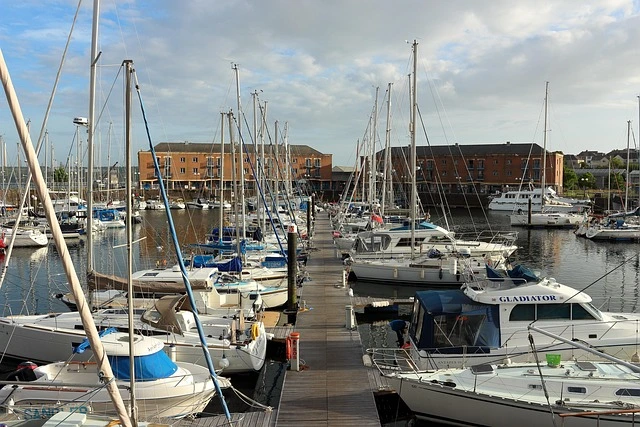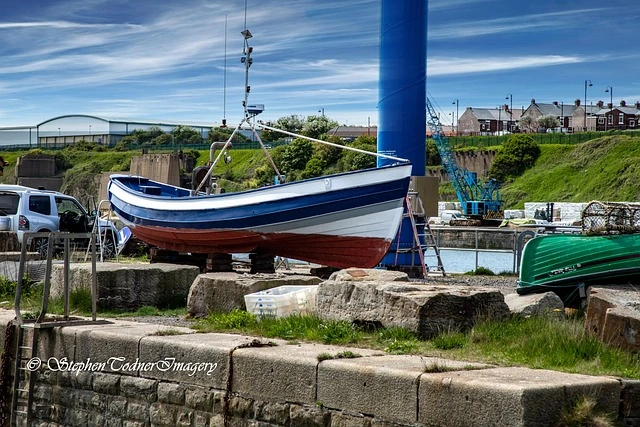Why Marina Operations Need to Become Data-Driven?
Say there is a bustling marina on a holiday weekend. Boats pulling in and out. Guests waiting for fuel, service techs rushing between slips, and phones ringing off the hook.
Now imagine this same marina, but with every slip assignment optimized automatically. Maintenance jobs scheduled before issues arise. Inventory tracked in real time, and staff’s decisions backed by live data.
Data analytics in the marine industry helps you gain the ability to anticipate and react. With live updates on berth occupancy, service tasks, inventory, and guest activity, teams can make faster decisions, reduce operational friction, and improve every part of the customer experience.
In this blog, we’ll discuss how DockMaster, a digital marina management software, streamlines operations and organizes data.

What “Data-Driven” Really Means for Marinas?
Being data-driven means letting real-time information help you in revolutionizing marina operations. Marina operators can experience a shift from relying on instinct and scattered spreadsheets to confidently controlling data analytics.
The information flows across departments, connects workflows, and empowers your team to act before problems escalate. For example:
-
Berth occupancy data shows which slips are available or in use
-
Maintenance records track what equipment needs servicing and when
-
Guest data reveals who your visitors are, what services they use, and how often they return
-
Fuel levels help prevent shortages and manage reordering
-
Store inventory shows what’s in stock and what’s running low
-
Service tasks highlight what work is in progress, completed, or overdue
After collecting this information, you can make informed decisions based on the evidence. Marina management data analytics also allows you to forecast busy periods and prepare in advance.
You can schedule repairs before they become necessary and tailor services to meet your guests' needs most effectively to enhance operational efficiency.
Key Areas Where Data Can Transform Marina Ops
In a marina industry, where even the slightest delay can ripple into guest frustration or revenue loss, access to real-time information can completely reshape how the team operates.
You can use those numbers to improve timing, service, and decision-making at every level of the business. Below are the four areas where this shift to data-driven marine operations makes the most visible impact:
1. Berth & Occupancy Management
Few things impact daily marina flow more than slip availability. On busy days, managing berth space becomes a game of speed and accuracy. Without visibility, double bookings and idle slips become inevitable.
But with access to live occupancy data, historical usage trends, and automated systems, marinas gain the clarity to plan and respond in the moment.
Data helps answer key questions:
-
Which slips turn over most often?
-
When do surges in check-in or check-out typically occur?
-
Are guests staying longer than expected, or leaving earlier?
When this information is readily available, staff can assign slips more confidently, balance long-term and transient demand, and support substantial cost savings. Over time, these patterns can even guide pricing or inform expansion plans. It’s one of the simplest ways to improve financial performance.
2. Service & Maintenance Scheduling
Most issues with docks, lifts, or service tools don’t happen suddenly; they result from missed warnings and delayed repairs. Data makes those patterns visible. It shows which assets are used the most and how long tasks take to complete.
Instead of responding after a failure, teams can:
-
Schedule maintenance based on real usage
-
Balance workloads by tracking technician capacity
-
Get early alerts for overdue jobs or missed steps
It will reduce manual labor, prevent surprise failures, and allow marinas to deliver a more seamless service experience.
3. Guest Behavior & Revenue Trends
Every guest interaction provides insight into customer behavior. It includes details about their preferences, visit frequency, spending habits, and the services they consistently book.
You can analyze that information and use it for improving services and maximizing loyalty.
You can see patterns like:
-
Some guests always book weekends and fuel up before leaving
-
Others prefer weekday stays and schedule minor maintenance
-
High-value customers may spend more on services than on dockage
These insights allow you to tailor offers, anticipate needs, and create more meaningful experiences by building customer satisfaction management software profiles. You can meet the guest where they are, with offers they actually value.

4. Inventory & Fuel Management
Inventory issues often go unnoticed until they interrupt service. A part is out of stock. The fuel tank is too low. A product sits untouched for months. Without clear tracking, supply chain blind spots appear at the worst time.
Real-time inventory and fuel data changes that. It shows what’s moving, what’s missing, and what’s misaligned. With the energy management systems in place, you can:
-
Identify low stock before it becomes urgent
-
Reduce waste by preventing over-ordering
-
Forecast seasonal shifts in product demand
-
Detect unusual fuel usage that may indicate leaks or theft
This improves operational efficiency and protects margins, two areas where even small changes compound over time.
How to Get Started with Data-Driven Marina Operations?

Becoming a data-driven marina isn’t about doing everything at once. It’s about starting with what you already have, understanding what’s missing, and building toward smarter, faster, and more connected management software.
Here are the four foundational steps:
Step 1: Audit What Data You Already Have
Every marina already runs on scattered, uncaptured, or shared data. Before introducing any new technology, take a comprehensive look at the information already flowing through it.
Start by looking at each touchpoint:
-
Where are your bookings recorded?
-
How do you track fuel levels or part usage?
-
Are guest preferences logged, or just remembered by staff?
-
Do service teams track jobs digitally or rely on paper?
You might find that slip assignments live in a spreadsheet, inventory counts in a notepad, and maintenance schedules in someone’s head. A clear audit helps you spot duplicated work or missing records, identify which processes could be automated, and uncover unused data.
Step 2: Choose a Smart Marina Software
You should opt for a platform that can bring all your operations together. DockMaster is for marinas that want to transition from an individual approach to a holistic system and expand their digital presence.
It centralizes your operations with features like:
-
A visual marina map to manage slip occupancy in real time using DockMaster Visual Marina Management
-
Online and DockMaster Point-of-Sale (POS) linked reservations systems for fuel, dockage, and retail purchases
-
DockMaster Mobile service tools that let technicians receive jobs, track time, and upload photos in the field
-
DockMaster Inventory Management and control systems that sync automatically with parts usage and sales
-
A DockMaster CRM that captures guest history and gathers customer feedback alongside preferences, documents, and communications
It connects the dots between every department, reduces duplicate entries, and displays what’s happening across the marina to significantly enhance operational efficiency.
Step 3: Set KPIs and Goals
Data collection is useful when you know why and what you’re measuring. Key Performance Indicators (KPIs) help you stay focused on what matters: efficiency, guest satisfaction, and revenue growth.
Start with practical, day-to-day indicators:
-
Berth occupancy rate: Are your slips being used effectively?
-
Service turnaround time: Are repairs and requests handled on time?
-
Inventory turnover: Are you stocking too much or not enough?
-
Monthly revenue per slip: Are your services aligned with guest behavior?
-
Guest retention rate: Are people coming back, and why (or why not)?
With DockMaster, you can track these KPIs through customizable dashboards. Over time, you’ll be able to compare performance across seasons, departments, or teams and spot issues early, before they affect your bottom line.
📌Tie KPIs to team roles. For example, service teams might focus on repair turnaround time, while the front desk might track guest booking conversions. It will produce meaningful metrics.
Step 4: Train Your Team to Read & Use Data
Marina managers should show their team how to use the data they already interact with. It will help them feel confident in using the tools and technologies available.
Here’s what that looks like:
-
Service technicians using DockMaster Mobile to update job status and track hours as they work
-
Front-desk staff viewing guest history before assigning a slip or sending reminders
-
Managers reviewing dashboards weekly to adjust staffing or promotions
Over time, this shift turns data into habit. Instead of reacting to problems, teams start anticipating needs and making decisions with clarity and speed.
📌When marina managers and staff can see how their actions drive results, they’ll be more likely to engage daily.
Tools & Tech Powering Data-Driven Marinas
Running a data-driven marina simplifies complex tasks across departments. Here are a few tools that make everyday decisions clearer and operations far more efficient.
1. Smart Sensors & IoT Devices
The physical infrastructure of a marina, such as slips, fuel docks, and electrical hookups, holds valuable information. But without sensors or smart tracking, much of that data is invisible.
Maintenance tracking IoT devices (Internet of Things) now make it possible to monitor everything from:
-
Fuel tank levels and pump activity
-
Water and electricity consumption at individual slips
-
Security gate access and dock movement
-
Environmental factors like water quality or temperature
You receive early alerts, usage reports, and automatic logs when these devices are connected to your management system. This visibility turns maintenance, billing, and utility oversight into proactive, low-effort tasks.
2. Mobile Apps That Extend the Office to the Dock
Delays in communication lead to missed details, duplicated labor, and longer job cycles. DockMaster Mobile solves this by giving your techs the tools they need, right in their pocket. Whether they’re in the yard or out on the dock, they can:
-
View assigned and open jobs in real time
-
Start/stop time tracking with built-in timers or manual input
-
Log notes using voice-to-text so they don’t lose time typing
-
Upload photos or documents from the field and attach them to specific work orders
-
Check part availability and service history before starting the task
Every update syncs instantly with DockMaster Desktop. That means your service coordinator sees what’s happening as it unfolds without any lag or confusion.
Your team also benefits from the Mobile Scheduler, a color-coded calendar showing which jobs are scheduled, in progress, or delayed. This enables field staff to be aware of upcoming tasks and perform them seamlessly.
3. Energy & Facility Monitoring
Utility costs can significantly impact your margins if not closely monitored. Pumps that run longer than needed, dock lights that stay on all night, or unnoticed water leaks can add up fast. However, these issues often go unseen until the bill arrives.
Digital tools that track usage patterns enable marinas to reduce waste, prevent overuse, and plan upgrades. They turn invisible costs into visible, manageable data points.
With the right tools, you can:
-
Catch unusual usage spikes early, whether it's a leaking pipe or a faulty charger
-
Monitor high-consumption assets, like fuel pumps, dock lights, or HVAC systems, to see when and how they’re used
-
Set usage thresholds and alerts to warn staff before problems become expensive
-
Plan maintenance based on equipment behavior, saving time and extending asset life
Even if you don’t have a comprehensive energy dashboard yet, systems that log and link this data enable you to shift from reactive troubleshooting to predictive, cost-aware facility planning.
Real-World Examples: Data-Driven Success in Action
Founded in 1989, Atlantic Boats in Wareham, Massachusetts, is a full-service marine business offering boat sales, service, storage, rentals, and parts. With multiple revenue streams and departments to manage, they recognized that manual systems would limit their growth.
Over a decade ago, they adopted DockMaster to run the business on better information. Since then, its data tools have become central to how they plan, respond, and scale their operations.
This approach was tested in 2020, when local demand exploded during the pandemic. The marina saw a sharp increase in bookings, service requests, and store traffic. They leveraged the data already flowing through DockMaster to stay in control.
1. Turning Inventory Data into Confident Planning
Each department used real-time inventory data to stay stocked. Daily sales reports and location-based tracking revealed which parts were selling. Staff knew which location was low in, how often it sold, and whether it was needed for upcoming service jobs.
That visibility allowed them to:
-
Forecast stock needs ahead of weekend rushes
-
Automate reordering using sales history
-
Avoid overstocking slow-moving items
2. Customer Insights That Improve Service Quality
DockMaster’s CRM connects vessel info, past purchases, service history, and notes into a single, usable record. Atlantic Boats used this opportunity and tool to personalize every customer interaction.
This helped them:
-
Respond faster to returning customers
-
Pre-fill service requests with known vessel details
-
Anticipate needs based on historical behavior
The team could identify which guests typically stayed in winter, booked fuel in spring, or requested specific accessories. That data helped them engage more proactively, without asking customers to repeat themselves.
3. Real-Time Job Data for Smarter Service Management
In the service department, DockMaster enabled technicians and managers to track work order data in real-time. They had all the necessary information, including parts used, hours logged, and job status.
It helped them:
-
Allocate labor based on job complexity
-
See profit margins per job by comparing billed hours to actual costs
-
Identify bottlenecks in the workflow and reassign tasks to stay on track
Jason Lindstrom, Marine Store Manager at Atlantic Boats, says it best:
“For businesses still running their operations on pen and paper, they don’t know what they’re missing out on. DockMaster brings so much more ease and efficiency to marina businesses. I still keep paper and notes out of habit, but at the same time I really don’t have to, because 99% of the transactions and correspondence is stored in the software.”
Common Challenges & How to Overcome Them
Here are the most common obstacles in adopting a data-driven approach in marine operations and how to move past them:
1. Upfront Costs
New software. Mobile devices. Updated workflows. It’s easy to look at digital transformation and assume it means spending more than you can afford at the moment.
However, you can start small by beginning with one department, such as reservations or maintenance, and automating a single manual process (like slip assignments or time tracking).
2. Staff Resistance to Change
Even the most reliable team can feel hesitant when introduced to new tech. They may worry that learning a new system will slow them down or that data will result in more tracking, more reports, and more oversight.
To combat this, you can:
-
Involve staff early: Ask what slows them down now, and where they see room to improve
-
Show the ‘why’: Frame data as a tool to help them do their job better
-
Train with use cases: Show how service techs can close jobs faster, or how the front desk can avoid double-bookings
3. Disconnected Tools
Many marinas already use a mix of tools, including spreadsheets, POS terminals, and handwritten logs. But when none of them work with each other, you end up with fragmented data and extra work just to stitch the picture together.
To overcome this, look for:
-
Software that integrates reservations, service, billing, and inventory
-
Tools with built-in reporting and real-time updates
-
Platforms that grow with you, instead of requiring costly add-ons later
4. Lack of Clarity
One of the most overlooked challenges is simply not knowing what the first step should be. The options can feel overwhelming, and that can stall progress before it even begins.
Here’s a better approach:
-
Start with a data audit (as outlined earlier)
-
Pick one core area that’s slowing you down, like slip allocation or job tracking
-
Choose tools with marina-specific experience and a clear onboarding process
-
Keep the focus narrow: progress over perfection
The Future Outlook for Data in Marina Management
Marinas operate best when they invest in predictive analytics, automation, and real-time tracking. They can reap greater control, reduced waste, and stronger guest satisfaction. For example, predictive maintenance initiatives have been shown to reduce downtime by 35% to 50% in the maritime sector.
Here are a few other future-focused trends to keep an eye on:
-
Cloud-based marina software enabling access from any device, removing location restrictions, and simplifying how your team updates records, reviews schedules, or responds to guest requests
-
IoT sensors and smart meters monitoring dock activity, utility consumption, and equipment performance, making it easier to identify areas with irregularities and optimize usage across the marina
-
Centralized dashboards and analytics bringing together service history, occupancy rates, revenue trends, and inventory flow into one place for faster decision-making
-
Sustainability metrics measuring your marina’s progress on energy usage, water consumption, and emissions reduction by staying compliant and recognizing environmental stewardship
Final Thoughts: Start Small, Scale Smart
Improving your marina operations with data can enhance efficiency. Start by identifying the most pressing friction points, like manual slip assignments, missed service tasks, or unclear inventory levels, and explore how management software streamlines operations to resolve them.
With tools like DockMaster, you get access to maintenance tracking, customer behavior insights, and energy management systems. You can track ROI and deliver a seamless service experience.
In modern marina management, automated systems, improved docking, optimized energy, and aligned sustainability needs will play a crucial role. So don’t wait for a complete redesign.
In the future of modern marina management, automated systems, improved docking, optimized labor, and aligned sustainability needs will play a crucial role. So don’t wait for a complete redesign.
Let DockMaster help you scale confidently, one data-driven decision at a time.
Contact us today to learn how DockMaster’s marina management software can complement your next phase of growth and enhance customer experience.
